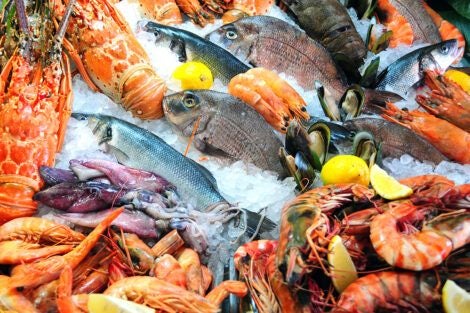September 17, 2021—Nutrition researchers have long touted the health benefits of fish such as salmon, cod, and herring. But the world’s waterways, from the depths of the oceans to the cutbanks of rivers to tropical reefs, offer up an incredibly diverse bounty of food sources that people around the world depend on.
To better understand the nutritional benefits of the full spectrum of aquatic foods, Harvard T.H. Chan School of Public Health’s Christopher Golden and colleagues created individual nutrient profiles for more than 3,750 species, ranging from water spinach to clams and cockles to sockeye salmon. The nutrient information is contained in the newly created Aquatic Foods Composition Database, which is open-access and available for download.
The study, published on September 15, 2021 in Nature, determined the top seven categories of nutrient-rich animal-source foods are all aquatic and include pelagic fish (sardines, herring, and other species), bivalves, and salmonids (salmon, trout, and related fish). Sustainably ramping up production and consumption of these foods through aquaculture (or farming in the ocean), supply chain improvements, and better fisheries management is critical to addressing staggering global levels of malnutrition and associated micronutrient deficiencies, Golden said.
Currently, billions of people suffer from one or more forms of malnutrition and half the world’s children have micronutrient deficiencies. Public health experts and policy makers have increasingly focused on the importance of sustainable and healthy diets to overcome these challenges, but many analyses emphasize terrestrial food sources and tend to frame aquatic foods as a largely monolithic category of “seafood or fish.” This oversimplified categorization results in aquatic foods being undervalued as a nutritional solution and often overlooks the myriad micronutrients they offer, according to the researchers.
“Aquatic foods seem to be a unique win-win,” said Golden, assistant professor of nutrition and planetary health. “They have very high nutrient richness and also can be produced with relatively low environmental impacts in comparison to terrestrial meats.”
To provide a more robust and nuanced understanding of the potential nutritional benefits of aquatic foods, Golden and colleagues built the Aquatic Foods Composition Database to characterize levels of hundreds of nutrients—including minerals (calcium, iron, and zinc, among others), vitamins, and fatty acids—across 3,753 aquatic food species.
In addition to documenting the nutritional profiles of aquatic foods, the researchers wanted to know how different levels of global aquatic food production and consumption would affect human nutrition at the population level. To learn more, they examined two scenarios: a baseline scenario that featured moderate growth in aquatic food production and a high-production scenario in which aquatic food supplies are increased by 15.5 metric tons—or approximately 8% over current levels—by 2030.
The high-production scenario resulted in significantly higher intake of DHA+EPA (types of omega-3 long-chain polyunsaturated fatty acids), calcium, iron, and vitamin B12 and prevented 166 million nutrient deficiencies. In this scenario, aquatic foods accounted for 13.7% of global protein intake and 2.2% of all calories consumed.
The study and the Aquatic Foods Composition Database have important implications for nutrition and fishery management policies across the world, Golden said. For example, if calcium deficiency is an issue in Turkey, the country may want to consider increasing the consumption of herring, sardines, or other small pelagic fish, which are rich sources of the mineral. If vitamin A deficiency is an issue in Brazil, it may make sense for the country to promote the production of oysters or the consumption of sardines, both of which are high in vitamin A.
“In an effort to formulate food systems that will nourish the world while staying within the ecological limits of our planetary boundaries, aquatic food production is a sensible path forward,” Golden said.
The study was part of the Blue Food Assessment, a comprehensive examination of the role of aquatic foods in building healthy, sustainable, and equitable food systems. Other Harvard Chan School researchers who contributed to the study included Simone Passarelli, Daniel Viana, Alon Shepon, Eric Rimm, Goodarz Danaei, and Heather Kelahan. Camille DeSisto also contributed while an undergraduate at Harvard College.
Learn more:
Aquatic Foods (The Nutrition Source)
Blue Foods (Nature)
Harness the world’s aquatic ‘blue’ food system to help end hunger (Nature)
Photo: iStock
